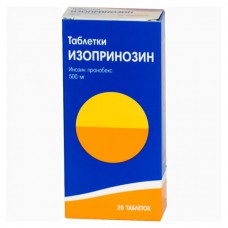Expiration date: 12/2026
Product form, composition and packaging
Tablets white or almost white, oblong, biconvex, with a slight amine odor, with a risk on one side.
Auxiliary substances: mannitol-67 mg, wheat starch-67 mg, povidone-10 mg, magnesium stearate-6 mg. 10 PCs. - blisters (2) - packs cardboard.
10 PCs. - blisters (3) - packs cardboard.
10 PCs. - blisters (5) - packs cardboard.
1 tablet contains: inosine pranobex 500 mg
Clinico-pharmacological group: Immunostimulating drug
Pharmaco-therapeutic group: Immunostimulatory agent
Indications
- treatment of influenza and other respiratory,
- infections caused by herpes simplex virus types 1, 2, 3 and 4: genital and labial herpes, herpes keratitis,
- shingles, chicken pox,
- infectious mononucleosis caused by the Epstein-Barr virus,
- cytomegalovirus infection,
- measles, severe course,
- human papillomavirus infection: papillomas of the larynx/vocal cords (fibrous type), genital HPV infection in men and women warts,
- molluscum contagiosum.
Dosage regimen
Tablets are taken after meals, drinking a small amount of water.
The recommended daily dose for adults and children aged 3 years and older (weighing 15-20 kg) is 50 mg/kg body weight in 3-4 admission (for adults - 6-8 tab./ day, for children - 1/2 tab. 5 kg body weight / day).
In severe forms of infectious diseases the dose can be increased individually up to 100 mg/kg of body weight/day, divided into 4-6 receptions. The maximum daily dose for adults is 3-4 g / day, for children-50 mg/kg / day.
The duration of treatment for acute diseases in adults and children is from 5 to 14 days. Treatment should be continued until the clinical symptoms disappear and for another 2 days in the absence of symptoms. If necessary, the duration of treatment can be increased individually under the supervision of a doctor.
In chronic recurrent diseases in adults and children, treatment should be continued for several courses of 5-10 days with a break in admission of 8 days.
For maintenance therapy dose may be reduced to 500-1000 mg / day (1-2 tab.) within 30 days.
In herpetic infection, adults and children are prescribed the drug for 5-10 days before the disappearance of symptoms, in the asymptomatic period - 1 tab. 2 times / day for 30 days to reduce the number of relapses.
In human papillomavirus infection adults the drug is prescribed 2 tablets. 3 times/ day, children-1/2 tab. 5 pounds/body weight/day in 3-4 divided doses for 14-28 days as monotherapy.
With recurrent genital warts adults drug is prescribed 2 tablets. 3 times/ day, children-1/2 tab. on 5 kg / body weight / day in 3-4 doses, either as monotherapy or in combination with surgical treatment for 14-28 days, then with a triple repetition of the course at intervals of 1 month.
In cervical dysplasia associated with human papilloma virus, appoint 2 tab. 3 times/day for 10 days, then spend the same 2-3 courses with an interval of 10-14 days.
Side effect
The frequency of side effects after the drug is classified according to who recommendations: often (?1%, <, 10%), 0="" 1="" p="">
From the digestive system: often-nausea, vomiting, epigastric pain, a temporary increase in the activity of transaminases and schf in blood plasma, sometimes - diarrhea, constipation.
Dermatological reactions: often-itching.
From the nervous system: often - headache, dizziness, weakness, sometimes - drowsiness, insomnia.
From the urinary system: rarely - polyuria.
From the side of musculoskeletal system: often - pain in the joints.
Metabolism: often-exacerbation of gout, increased concentration of urea in blood plasma.
Contraindications to use
- urolithiasis,
- gout,
- arrhythmias,
- chronic renal failure,
- children under 3 years of age (body weight 15-20 kg),
- hypersensitivity to the components of the drug.
Application during pregnancy and breast-feeding
The safety of Isoprinosine in pregnancy and lactation is not established, so the use of the drug is not recommended.
Application for violations of liver function
After 4 weeks of use, it is advisable to monitor liver function (transaminase activity) every month.
Application for violations of renal function
Contraindicated in chronic renal failure, kidney stones.
After 4 weeks of use, it is advisable to monitor kidney function (creatinine, uric acid) every month.
Use in children
Contraindications: children under 3 years of age (body weight 15-20 kg).
Special instruction
After 2 weeks of using Isoprinosine is recommended to control the content of uric acid in the blood serum and urine.
With prolonged intake after 4 weeks of use, it is advisable to monitor liver and kidney function every month (transaminase activity in blood plasma, creatinine level, uric acid).
It is necessary to monitor the level of uric acid in the blood serum in the appointment of Izoprinozina combined with drugs that increase the level of uric acid or drugs that violate kidney function.
Influence on the ability to drive vehicles and control mechanisms
There are no special contraindications.
Overdose
Overdoses of Isoprinosine is not described.
Drug interaction
With simultaneous use of immunosuppressants can reduce the effectiveness of Isoprinosine.
Inhibitors of xanthine oxidase and uricosuric funds (including diuretics) can contribute to the risk of increasing the level of uric acid in the serum of patients taking Isoprinosine.




